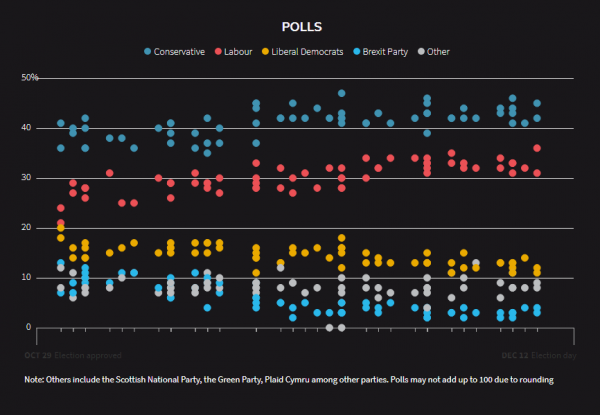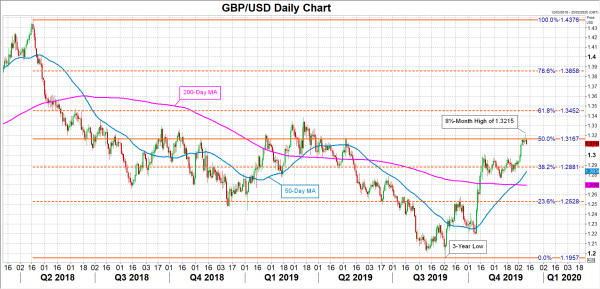Britons go to the polls on Thursday for a parliamentary general election that is likely to determine the outcome of Brexit. The election – the first to be held in December since 1923 – comes just two and a half years after Theresa May’s attempt to capitalize on her huge lead in the polls spectacularly backfired. The present prime minister, Boris Johnson, and his Conservative party appear to be having better success this time round, maintaining a sizeable lead over Labour in the run up to voting day. The pound has been rallying on the expectations that the Tories will win a decisive victory on December 12, ending months of political uncertainty. But even if Johnson was to secure a large majority, would that halt the Brexit chaos that has brought the UK economy to the brink of a recession?
Tories maintain lead in polls
With just 24 hours to go before polling stations across the United Kingdom open, Boris Johnson and his team are taking nothing for granted as they try not to repeat the mistake of Theresa May, who failed to adapt her election campaign in 2017 while Labour alarmingly crept up in the polls, resulting in the loss of her parliamentary majority. The low point for May’s government was at the European Parliament elections in May this year when the Tories came fifth behind the Brexit Party and Labour.
However, after Boris Johnson was elected as party leader in July, the Conservatives have fully recovered in the polls and the latest poll of polls puts the Tories at 43%, nine points ahead of Labour, who have risen to 34%. Labour’s gains have come mostly at the expense of the Liberal Democrats who appear to have lost their shine after coming second at the European elections, while the Conservatives have been clawing back lost Tory Brexiteers from the Brexit Party.
But race is tightening
If the polls prove accurate, Boris Johnson would be able to restore his party’s majority at Westminster and push through the Brexit deal he renegotiated with the European Union. However, the latest multilevel regression and post-stratification (MRP) poll by YouGov, which successfully predicted the outcome of the 2017 election, shows support for Johnson is waning. The first MRP poll from two weeks ago indicated the Tories were on course to win a big majority of 68 seats. In the latest poll out yesterday, that has shrunk to just 28, signalling the race has tightened and that there’s a higher chance of a hung parliament.
Would a Conservative majority clear the Brexit fog?
But while it’s true that a comfortable majority would aid Johnson to press on with his Brexit agenda and clear the fog that’s been clouding the outlook for the British economy since the 2016 referendum, it would not necessary remove all the risks.
For one, once the Withdrawal Agreement has been passed by Parliament and Britain officially leaves the EU on January 31, the focus would then turn on the future relationship, i.e. the trade deal. This carries two huge risks for the British economy. The first is Johnson is promising to get all the negotiations done in less than a year to ensure that a transition period beyond December 2020 (as negotiated in the Withdrawal Agreement) won’t be required. However, trade negotiations normally take years and it’s extremely unlikely the UK and the EU will be able to complete a deal by the end of 2020.
This suggests Johnson could use the December 2020 deadline to coerce the EU in finalizing a quick deal by keeping alive the threat of a no-deal Brexit. Without a post-Brexit trade agreement, the UK and the EU would revert to WTO rules as the Withdrawal Agreement covers primarily the terms of their divorce and only a non-binding declaration on the future relationship.
Secondly, even if all was to go well, it’s worth being reminded that Boris Johnson wants to pursue a looser relationship with the EU than his predecessor did. Johnson will most likely aim for a ‘Canada style’ trade deal and the compromises he was willing to make over Northern Ireland to get the backstop removed are strong evidence of this.
Has the pound rally much room to run?
All this suggests investors may see little case in driving sterling much higher once a Johnson victory is confirmed. Cable is currently trading around the 50% Fibonacci retracement of the April 2018 to September 2019 downleg at $1.3167. A decisive election win for the Conservatives could stretch the rally to the 61.8% Fibonacci at $1.3452. However, a break above this resistance may not be easy if Johnson pushes for a ‘hard’ Brexit.
In the surprise event that there is a repeat of a hung parliament, the pound’s first stop to the south would be the 38.2% Fibonacci at $1.2881, followed by the 200-day moving average in the $1.27 region and the 23.6% Fibonacci at $1.2528.
While a hung parliament is not the desired outcome for investors, the pound’s losses are likely to be contained if it lets in a Labour-led coalition that is in favour of holding a second referendum. The idea of a second referendum may even prove less negative for sterling than a minority Conservative government that could see the Brexit crisis dragging on indefinitely. Either way, it’s hard to see this week’s election eliminating all the Brexit uncertainties for the UK economy as many traders have been hoping for.














